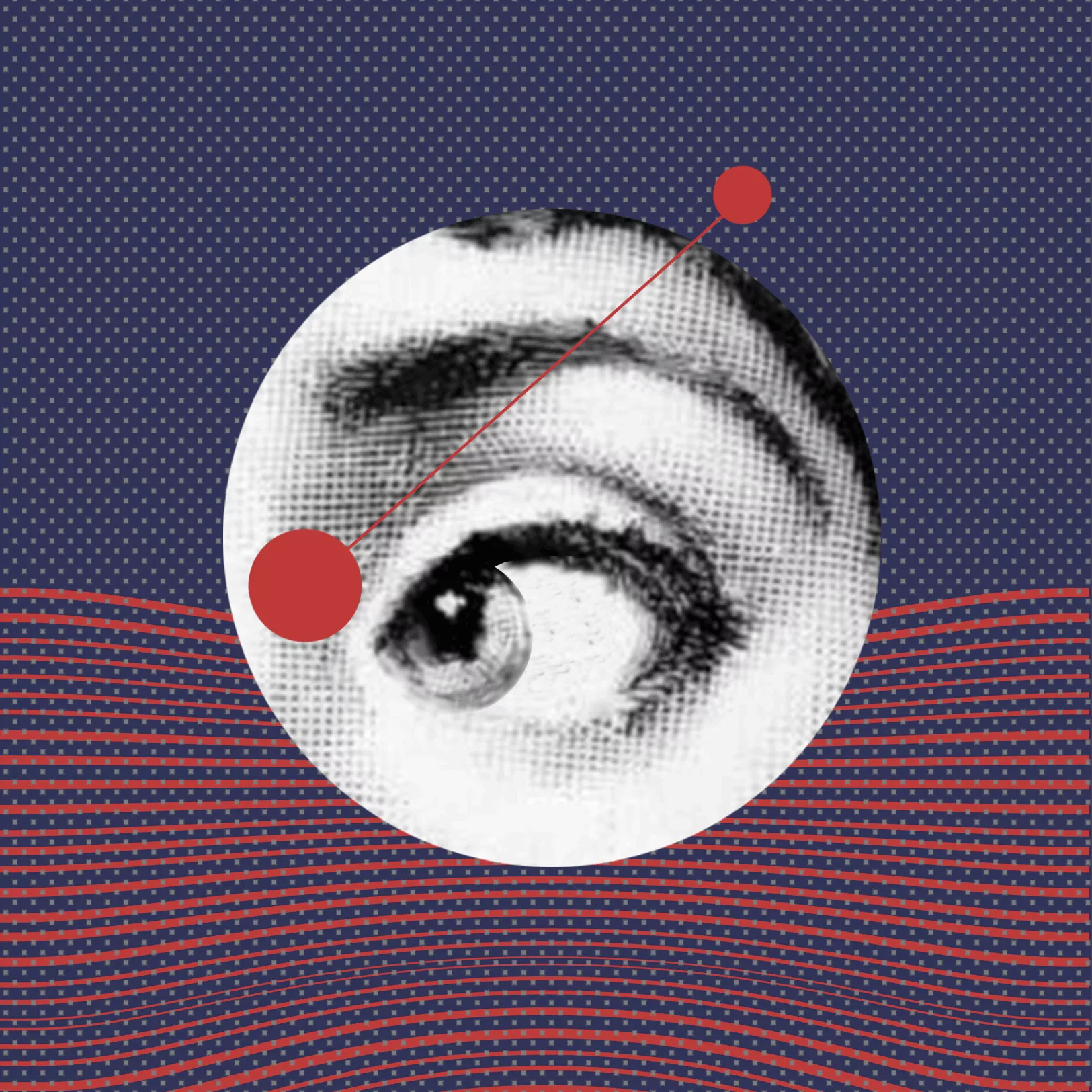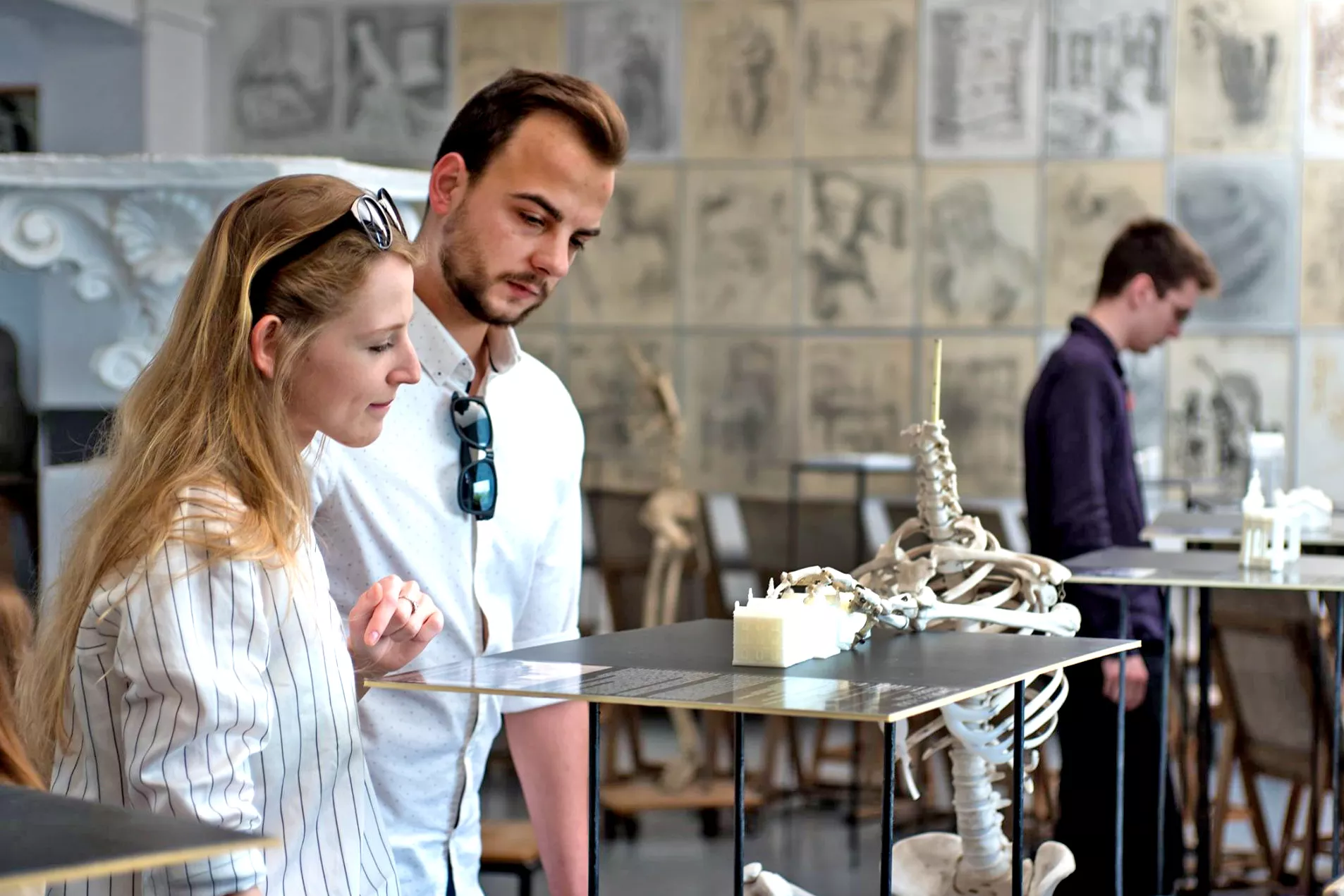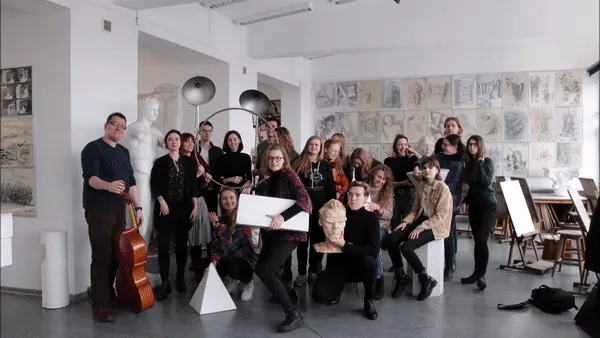Out of the corner of our eyes, we see aspects that give us a slightly different perspective. The guests of this interview are able to rise above the clouds and learn about architecture in a completely different context. Joanna Kurnyta and Aleksander Placek discuss why it is worthwhile to relax on the red poufs and not only see but also hear the architecture.
The Research Group 'Kąt' is based at the Institute of Architecture and Urban Planning TUL. Where did the idea for such an initiative and its name come from?

Joanna Kurnyta (former Chair): Twelve years ago, the founders wanted to find a place to meet. On the ground floor of our faculty is the library, and to its left the 'KĄT' got a corner for itself. I think it's a good association - they found their corner, besides, it's a geometric form. Our research group is the kind of place where we have strived to create a supportive community without divisions. Unfortunately, the architecture market can be tough, so I was happy we could talk about it. Even if someone is not the club member, we hold open events, and anyone can come and exchange views and share experiences with us.
Aleksander Placek (Chairman): The idea of setting up such a group is nothing more than a gathering of people with similar interests who together try to create something and understand each other.
You also use the name 'Red Poufs'. Where did this idea come from?
JK: When the original founders were furnishing the 'KĄT' and, in the process, creating plywood furniture, they decided that red poufs would be a good accent. This element stood out so much that both names were created simultaneously. We still have the red poufs, but they are different now because we bought new ones. (Laughs) These different names are problematic in the media we operate on (e.g. Instagram), but we won't change that.
AP: I would add that the poufs themselves are loved by the students, especially as they sometimes take a nap on them to rest between classes.
"KĄT" is the place for design lovers. What activities are you most proud of?
AP: I asked the members who have been contributing to the group for the last three years, and most definitely chose the '10 Corners' event, where we did panel discussions with architects and interior designers. Added to this was an exhibition of engineering work in the Sports Bay. I am also pleased that during the pandemic and the lockdown of the university we still wanted to act. This is how the 'From Lego to AutoCad master' campaign was launched to provide advice and guidance to those interested in studying architecture at TUL. The second thing during this period was the continuation of the 'Out of the Corner of the Eye’ series, where we created playlists of songs that inspire the architects, as well as podcasts on various topics.
JK: There is a lot going on in the 'Kąt', but not so regularly because everyone has their own ideas. I have good memories of working on the installation for the Light Move Festival – clouds over Piotrkowska Street - because that is where my strong involvement in the Research Group began. I worked on the project together with Asia Sikorska and the other mates from the Kąt - we managed to create a great installation. I will also add to the list the models we made with a 3D printer, built and programmed by group member Aleksandra Dynarka. We created buildings on it that no longer exist in Lodz, but which became permanently inscribed in the city's history and memory. Every now and then we get a phone call asking if someone can borrow it again, and we did them six years ago – there have been several exhibitions. We were also at 'Design Week' for which students prepared furniture inspired by Lodz's urban planning. For us, even the smallest meeting was great fun. We enjoy working with each other.
It's great that you form such a close-knit team. I would like to ask more about the "Out of the corner of my eye" podcast, which Aleksander mentioned. What is the history of this project? Do you have a favorite recording?

JK: The podcasts were a pandemic effect and a way of reactivating the group. We had a moment of downtime during the lockdown, but at some point, we realized that there should be open days coming up. So, we came up with an online event in our faculty. The number of interested people exceeded our expectations and the campaign spread across the whole TUL. This was the first moment that made us realize that we were easily reaching a large group of people who were following us. The idea was to create a hybrid but cyclical event. These were supposed to be posts with interesting information that we put on Instagram. When the cinemas opened, we did two screenings at Cinema Charlie. 60% of our actions involve thinking about doing something for us, students, learning something, getting to know someone. We missed the meetings and conferences we did at the university. We later realized that many of the events were not recorded – which is a shame. If it had been otherwise, we would have a library. That is why the idea of podcasts. Without Adam Dziąg, who is a professional cameraman and sound engineer, and Radio Żak, this would never have happened. Anyone who was willing had a chance to get involved.
AP: For me, the most interesting meeting was with Patryk Hardziej due to the fact that I was preparing for it with Aleksandra Błęcka. We were very interested in the topic at the time – it was about manipulation through images/graphics. A significant number of people love the podcast with Olga Drenda. We are planning the next recordings, but we don't know yet with whom or when.
It sounds very inspiring. If someone would like to start working with you, how can they join the 'Kąt'?
AP: We currently have around 30 members and enrolment is usually in the new academic year. We try to hold meetings once a week at the faculty. They are important especially for newcomers, who then feel more at ease in a new environment, give more and want to help. The first two years of study involve tackling a fair number of faculty hours and a large dose of new knowledge. Our tasks are adapted to the time we have at our disposal.
JK: If you want to be active in a research group, you have to be able to cope with your studies. Internal organization is key, and our future employer also pays attention to this. We need to know our capabilities and manage them well. When someone new joins us, we give them time to get to know the group. We simply say: observe, think if you can work with such a team. We operate differently and this does not suit everyone. Sometimes there's more work because there's an idea that needs to be done quickly, then there's a break – we just get together and exchange experiences in the context of what's going on at the university. We welcome people with different aspirations. When someone has an idea, it's unlikely that anybody will say that it won't work. We defused this bomb from the inside. When it blew up, it failed, and when it did, there was some success. Remember that you can sign up all year round - Facebook, Instagram, mailing. We have contracts that we sign, rules and regulations but we don't have much bureaucracy. We need committed people who like us and want to work.
Does being active in a student research group help anything?
JK: As of this year, I am a TUL graduate. At work, I am an architect and do interior design. I have been working for the OSOM group for 4.5 years and have been active in SKN KĄT for 6 years. The company is close to Lodz University of Technology, so it was easy for me - running from university to work and from work to group meetings. After my first internship, I stayed at OSOM because I made an impression with the way I was organized and carried out my duties without embarrassment, such as calling contractors or talking to clients. When I went to one of the biggest developers in the city, asking for support for the research group, I would just shake hands and start talking to them. Working at the 'Kąt' has given me room to work professionally. I used to give new people in the group after a probation period such tasks, which gave rise to a million questions at the beginning, but after a month everyone was implementing them. Of course, there are some people who are brave from the start, others assimilate this over time. Being active in a student research group teaches openness, networking, organization – these are soft skills, but extremely important. You don't get a certificate for them, but they let you gain many more other skills later on. Acting in a research group makes you less afraid of other things that might happen at work and in life.
AP: I have met great people with different interests, with whom you can talk all night and create a project. Older mates often advised me and helped me in subjects that were initially difficult. I have learned to transfer what is on paper to the real world. Definitely, in a research group you can overcome certain barriers, push the boundaries of comfort.
Interviewed: by Paulina Krygier
Photos: private archives of the interviewees.

